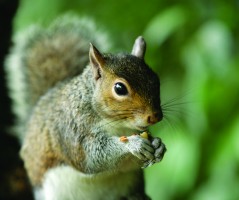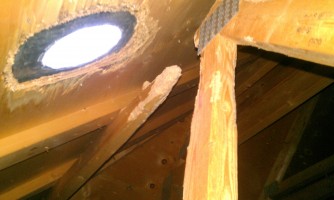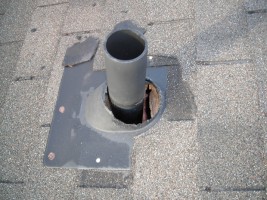Here at Skedaddle Humane Wildlife Control, we’re often asked which type of animal causes the most property damage. While the truth is that just about every urban wildlife species is capable of damaging a home, the worst offenders are most certainly squirrels. It doesn’t take very long for a group or family of squirrels to inflict thousands of dollars in home damage. In fact, some of the most badly damaged attics we have seen are those that have been occupied by squirrels.
 Squirrels are part of the rodent’s family, and are among the most successful of all mammals. The word rodent means “to gnaw”. They are expert chewers, as are all rodents. If rodents cannot chew on things, their teeth will grow to such lengths they become unmanageable. In fact, their front teeth can grow so long that they can’t use them any longer for eating and they will literally starve to death. It is in the squirrel’s best interest to chew on anything and everything it can- which means your home may be up for grabs.
Squirrels are part of the rodent’s family, and are among the most successful of all mammals. The word rodent means “to gnaw”. They are expert chewers, as are all rodents. If rodents cannot chew on things, their teeth will grow to such lengths they become unmanageable. In fact, their front teeth can grow so long that they can’t use them any longer for eating and they will literally starve to death. It is in the squirrel’s best interest to chew on anything and everything it can- which means your home may be up for grabs.
How Squirrels Enter Your Home
The sharp little nails of a squirrel allow it to climb without difficulty. Its keen whiskers can sense changes in air flow, and the warm air in your home may be very inviting. When it comes to squirrel chewing on your home, the important thing to remember is that they need a small gap or edge to get their teeth on to begin chewing, so that’s more or less the common thread between all the areas that squirrels use to get in a house. They all have an edge for them to start chewing on.
Any gaps or openings, no matter how small, which get created at the roof edge, are an open invitation for opportunistic squirrels. A bit of chewing and they are able to make a hole that suits them perfectly. Once inside the attic, they have found a warm and dry home to nest in and are not interested in leaving anytime soon.
Vulnerable Parts of Your Home
Wood
 Wood is a primary material for squirrels to wear their teeth on. They can chew right through the wood of your house in order to get inside.
Wood is a primary material for squirrels to wear their teeth on. They can chew right through the wood of your house in order to get inside.
Pipes
Copper pipes are fairly soft and can be chewed up, causing all kinds of problems, like flooding your house. Determined squirrels can also chew through PVC pipes. Even lead pipes have been reported to be chewed through. If they chew through a natural gas pipe, it can be very dangerous.
Shingles
In an hour or less squirrels can chew through a layer of shingles and gain entry into your attic to start nesting. If you apply weak steel barriers or screening to prevent them, they’ll chew right through it again.
Vents
The plastic and aluminum vents on your roof are installed to allow for proper attic ventilation. Unfortunately, curious squirrels are able to feel the warm air escaping the attic and know that they can find a cozy place to nest by chewing past the vent cover. Squirrels can also enter the home by chewing through the plastic bathroom fan vent covers found on the outside of the home.
Fascia
Chewed wooden fascia boards are a common squirrel entry point. The edge is where all the rain and melted snow that on your roof eventually ends up. Ice dams, clogged gutters and vegetation all serve to keep this area more wet for longer periods than any other point along the roof. As a result, shingles and roof boards in this area tend to deteriorate more quickly, allowing squirrels the opportunity to create openings.
The way a squirrel’s mouth is designed makes it difficult for them gnaw holes through the top of your roof. The roof edge provides an angle for them to work and chew at until they can create a space large enough for them to enter.
Roof-Soffit intersections
Roof-Soffit Intersections are most often found where two roofs meet. At these points, shingles from the lower roof meet with the soffit from the upper section. When soffits are installed they often fail to meet flush with the shingle below. The resulting gap allows squirrels to run straight into your attic.
Gable Vents
Like roof vents, gable vents are designed to help circulate air through the attic. They are usually installed in pairs at opposite ends of the home. Constructed from wood, plastic or aluminum, the slats provide an edge that can be easily chewed by squirrels.
Plumbing Mats
 The cylindrical vents on your roof connect to your plumbing system and are used to exhaust sewer gases. When installing a plumbing vent, a hole is cut through the roof to extend the pipe outside. To make it easier to run the plumbing, the hole in the roof is usually cut much larger than necessary for the pipe. The open space at the base of the roof is then covered with rubber matting. Squirrels will chew at the soft rubber mat to nest in the attic space below.
The cylindrical vents on your roof connect to your plumbing system and are used to exhaust sewer gases. When installing a plumbing vent, a hole is cut through the roof to extend the pipe outside. To make it easier to run the plumbing, the hole in the roof is usually cut much larger than necessary for the pipe. The open space at the base of the roof is then covered with rubber matting. Squirrels will chew at the soft rubber mat to nest in the attic space below.
Chimneys
Uncapped chimneys are an open invitation for squirrels. Depending on the materials used to line the chimney, squirrels may or may not be able to come and go. Squirrels will often fall and become stuck at the bottom of chimneys. This is often the case with smooth steel and clay lined flues. When it comes to chimneys lined with brick, squirrels are able to ascend and descend with ease, allowing them to nest on top of the fireplace.
How to Get Squirrels out of your Home
Squirrels can cause severe damage to homes, present serious health risks from their droppings, and leave behind unwelcome odors.
The best way to prevent property damage by squirrels is to act quickly and evict them from your home as soon as possible. The longer squirrels are able to live inside your home, the more destruction they can cause. In just a few short weeks you could end up with a hefty repair bill.
Our process begins with a 35-50 point inspection of your property to determine how the squirrels getting in. We then provide you with a no obligation written quote that details our findings and explains exactly what is required to humanely get rid of the squirrels in your attic.
If you suspect your home or attic is playing host to furry house-guests, give Skedaddle a call at 1.888.592.0387.
We remove squirrels in from homes and business in: Kitchener-Waterloo, Cambridge, Guelph, London, Ottawa, Montreal and Halifax. Mississauga, Oakville, Burlington, Hamilton and Niagara.



